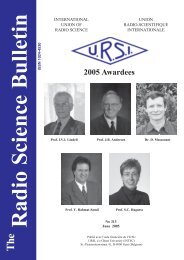Radio Science Bulletin 325 - June 2008 - URSI
Radio Science Bulletin 325 - June 2008 - URSI
Radio Science Bulletin 325 - June 2008 - URSI
- No tags were found...
You also want an ePaper? Increase the reach of your titles
YUMPU automatically turns print PDFs into web optimized ePapers that Google loves.
Typical OTH radar ionospheric soundings consist ofone or more vertical-incidence ionograms (VIs) andbackscatter ionograms (BIs), with soundings updated everyfew minutes. The backscatter ionograms are characterizedby the leading edge of one-hop propagation at the edge ofthe skip zone as a function of sounding frequency. In theCREDO approach, we first obtain the vertical electrondensity over the vertical ionosonde location(s) by one oftwo methods. The CREDO operator can select the ordinary(o-ray) or extraordinary (x-ray) one-hop trace using a fewmouse clicks, and then CREDO proceeds with directinversion of the vertical-incidence ionogram using thestandard method (augmented by a smart E-F valley model).Alternatively, in CREDO’s automated mode, an algorithmautomatically selects o-ray and x-ray points along the onehoptraces, and a vertical electron-density profile is adjusteduntil the corresponding synthesized ionogram suitably passesthrough the automatically-selected points. The verticalelectron-density profile over the (one or more) ionosondelocations is then used to sensibly adjust a climatologicalthree-dimensional ionosphere model so that it matches inthe ionosonde locations and extrapolates reasonably toremote locations. CREDO then proceeds by selecting severalbackscatter ionogram leading edge points in all backscatterionogram azimuthal sounding sectors. This selection caneither be done automatically using an impressively robustautomated point extraction (APEX) algorithm, or directlyby operator mouse clicks. The selected backscatter ionogramdata points are then fed to a three-dimensional ionosphericinversion algorithm that repeatedly adjusts the threedimensionalionosphere model until the synthesizedbackscatter ionogram leading edges obtained by Haselgroveray tracing agree with the input data. This inversion algorithmutilizes Tikhonov regularization to ensure that the resultantthree-dimensional ionosphere model is the smoothest oneconsistent with the input data. Note that all backscatterionogram azimuthal sectors are included in a single inversionto produce a true three-dimensional ionosphere model. Allof this can be done within about a minute after the soundingsare updated using a modern PC-class computer, providinga timely and accurate ionosphere model for OTH radarcoordinate registration. Details on the CREDO algorithmare given in [21, 22]. CREDO also includes the ability tooptionally include two-hop backscatter ionogram leadingedges and backscatter-ionogram-lobe trailing-edge data.Figure 8 shows the CREDO graphical user interface,called Ionoview, for an example of an OTH radar with asingle vertical-incidence ionogram sounding and eightazimuthal backscatter ionogram sounding sectors. Thevertical-incidence ionogram sounding is shown in the upperleftcorner pane, with the remaining panes exhibiting thebackscatter ionogram soundings, each separated by eightdegrees azimuth from the next. Boxes indicate the selectedvertical-incidence ionogram trace points and backscatterionogram leading edge data to be used in the CREDOinversion. Overlaying the backscatter ionogram soundingsare the synthesized one-hop (black circles) and two-hop(white circles) slant ranges (group path lengths) of theHaselgrove-generated rays in the resultant CREDOionosphere model fit, providing confirmation of the accuracyof the inversion.In our development of CREDO, we benefited bycollaboration (and friendly competition) with our colleaguesat the Australian DSTO. Dr. Chris Coleman developed hisown codes for solving Haselgrove’s Equations, and wecompared the speed of our respective codes. (Chris won.His secret: Instead of integrating Haselgrove’s Equations inspherical polar coordinates, as in the Jones-StephensonRaytrace program, he integrated in a Cartesian coordinatesystem, which greatly simplified the equations and reducedthe number of computational operations required to trace aray. He then transformed the result at the end to sphericalpolar coordinates.) Coleman used his Haselgrove integratorto develop a nice capability for simulating backscatterionograms [9].6. TID MitigationTraveling ionospheric disturbances (TIDs) remain atroubling cause of coordinate registration errors for OTHradar. OTH radar coordinate registration algorithms are notcurrently designed to account for TID-induced apparentmotion, and hence large coordinate-registration errors canresult. So far, it has been impossible to mitigate the effect ofTID-induced motions on OTH radar return signals.Conventional OTH radar soundings have neither the spatialnor temporal resolution to resolve TIDs. IonosphericallyinducedDoppler shift (IDOP) can be observed on OTHradar backscatter returns as a shifting of the centroid of thesurface clutter away from zero Doppler frequency. Weknow that to a large extent, ionospherically-induced Dopplershift is caused by TID activity. We also know a lot about thephysics of TIDs. They are driven by acoustic gravity waves(AGWs), which are buoyancy waves in the neutralatmosphere akin to water waves in the ocean. Because of theexponentially decreasing density of the neutral atmospherewith altitude, the energy from fairly minor disturbances inthe lower atmosphere turns into large-amplitude waves ataltitude, and these drive the ionosphere up and down thegeomagnetic field lines.In [23], we used Haselgrove ray tracing in modeledTID-affected ionospheres to demonstrate that for HFskywave paths, the slant-range rate determined by Dopplershift does not generally agree with the slant-range ratedetermined by the rate of change of group path, and thisdisagreement can be large, by factors of two or three or evenmore. We also showed that this disagreement appears inactual OTH radar measurements. The explanation for thisdiscrepancy has to do with certain “path change” terms forrefracted ray paths in the Fermat’s Principle calculation,which cancel each other in the phase path rate calculation(Doppler shift), but add together in the calculation of grouppath rate. An example is shown in Figure 9. In this case,10 MHz Haselgrove rays were homed to a fixed receiverlocation over a 2000 km link on an F2-layer low-raypropagation mode while a simulated TID passed through46The<strong>Radio</strong> <strong>Science</strong> <strong>Bulletin</strong> No <strong>325</strong> (<strong>June</strong> <strong>2008</strong>)
















